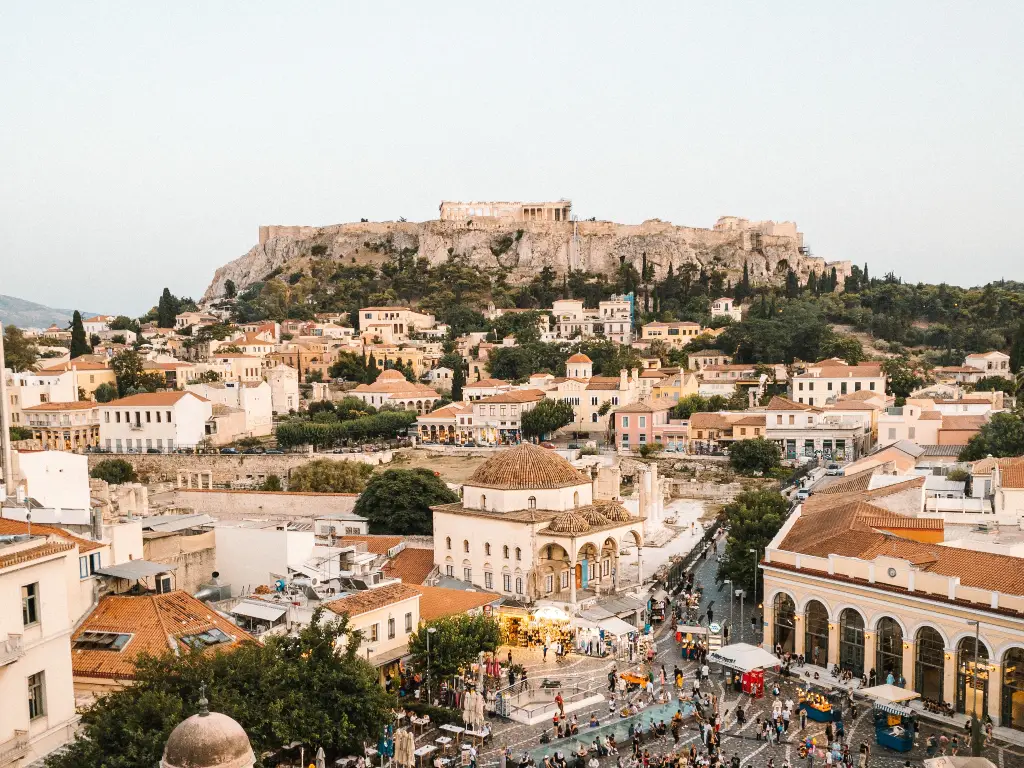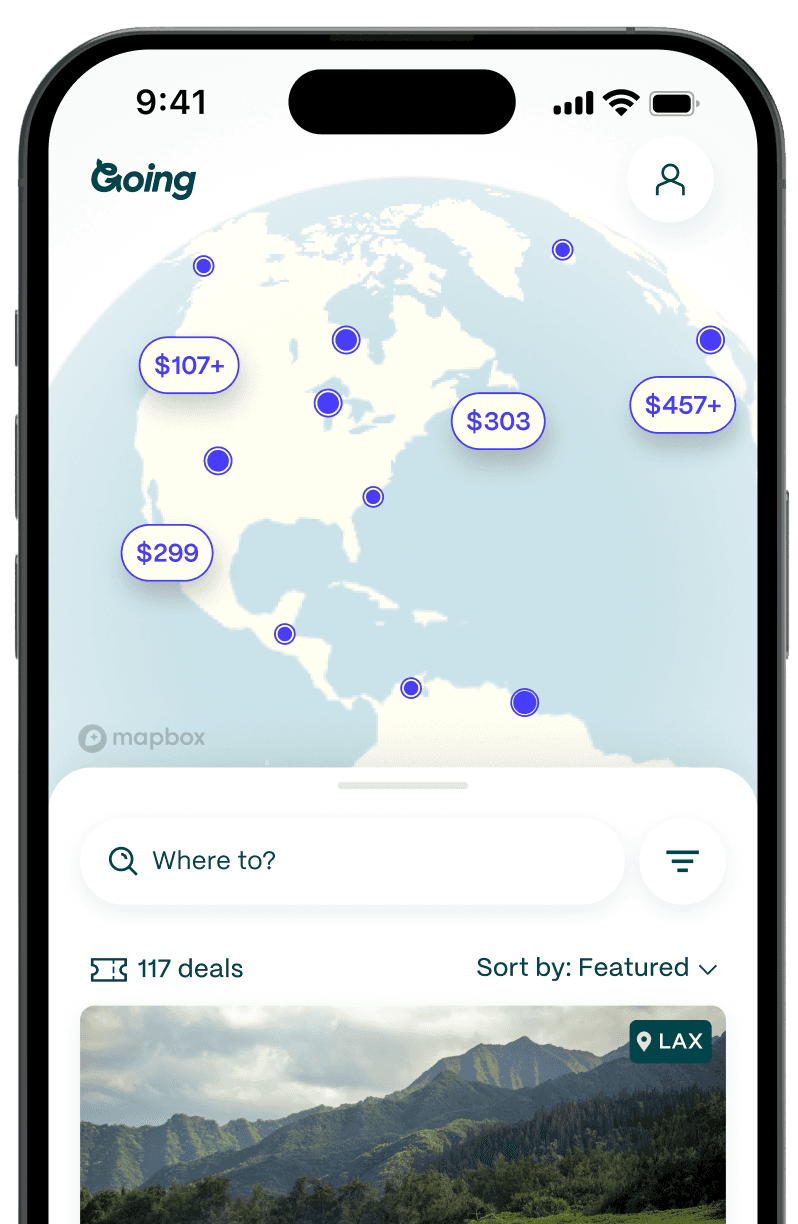
Athens: The Ancient Capital With the Oldest Street in Europe
Founded in 508 BCE, Athens is one of the world’s oldest cities. It’s famous for ancient sites such as the Parthenon and other ruins on virtually every corner. It’s also known as the Birthplace of Democracy and home to great philosophers such as Plato, Aristotle, and Socrates. In fact, both Plato’s Academy and the Lyceum, a temple used for philosophical debate for centuries, can be found in Athens.
Yet among Athens's over 3,000 years of human history is also an eclectic present. In between checking out neoclassical buildings or wandering a neighborhood styled like a Greek island, you can taste Greek delicacies in the central market or see some of the city’s many murals and street art projects.
The gift that gave the city its name
Athens has its name rooted in Greek mythology. A quarrel between the gods Poseidon and Athena for domination of the city saw a special court set up on the hill that is now home to the Acropolis to vote for its new patron and name. Poseidon and Athena were to offer gifts to the city, and the best would be judged as the winner. Poseidon—God of the Sea—gifted a spring of water. Alas, this water was salt, hence not drinkable or useful.
Athena planted an olive seed which immediately sprouted into a tree bearing olive fruits, the first in the whole country. With a gift that provided oxygen, shade, food, oil, and wood for the cold winters, Athena won and Athens was born. The gifted olive tree can still be seen on the Acropolis rock next to the caryatids statues of the Erechtheion.

Ancient relics in everyday life
Athens may be famous for the 5th-century BCE Parthenon ruins that sit on the top of a hill, but a stroll just about anywhere around the city is like stepping into a living museum.
Whenever antiquities are unearthed during any construction, much is left displayed in situ, which makes the most mundane places into free ‘museums.’ This is partly due to the fear that moving these ancient relics could damage them, but mainly because of an unofficial rule that the finds should be appreciated exactly where they were found to offer context to their past.

For example, when the metro was modernized for the 2004 Olympics, more than 50,000 artifacts were uncovered. Now, in metro stations across the city, you’ll see sections of clay pipes, once part of the Athenian water supply and sanitation system, and everyday items dating back to the 5th century BCE can be found in glass cases throughout the stations.
At the Acropolis station, excavations discovered between 1993 and 1996 include a bath complex and fragments of black and red-figured vessels used in the transportation of wine and olive oil. Monastiraki metro station offers a large collection of pottery fragments dating from the classical Roman to Byzantine eras plus the remains of various buildings dating back to the 8th century BCE.
Even the basement area of a Zara store, housed in an 1840s ex-residential building, has the ruins of an ancient Roman Tomb behind a glassed-off area, probably discovered during the nearby construction of Panepistimio metro station in 2000.
Neoclassical Athens
At first glance, architecturally modern Athens isn’t much to look at with its uniform 1950s and 1980s apartment blocks. Yet dig deeper and neo-classical buildings—an architectural style characterized by symmetrical shapes, tall columns, triangular pediments, and domed roofs—can be found in the Plaka district and scattered across the city, with many now museums and private residences.
As Athens emerged as the new capital of independent Greece in 1832, so did neoclassicism. The War of Independence between 1821 and 1832 had degraded the soul of not only the country but the people too. Athens being named the new capital gave them cause to celebrate, and neoclassicism became the style of choice for new buildings. Between 1950 and 1978, many buildings were destroyed to make way for modern apartment blocks, but luckily, several remain intact.
The Numismatic Museum near Syntagma Square is one such wonder. The three-story former mansion has an impressive marble stone stair entrance, patterned marble flooring, and high painted ceilings. Today it houses one of the most important collections of ancient and modern coins in the world.

An island within the mainland
Referred to as a hidden island in the mainland, Anafiotika is tucked away under the northeast side of the Acropolis. A stroll here feels a bit like visiting the islands without leaving the city.
The neighborhood was built in 1841 when the ruling King Otto ordered workers from Anaif, a tiny island in the Cyclades, to work on his palace. Homesick for their island, they constructed their neighborhood in the same style of white sugar cubed houses found in the Cyclades, with flat stone roofs and brightly painted wooden doors and shutters. Pink and white bougainvilleas wind their way up to the roofs, several of which have roof gardens.
Only 45 houses remain in this elderly, gentile neighborhood. Most of the people are retired, and the homes have been passed down through generations (while others were abandoned or demolished). Now, many of the cobbled alleyways are lined with inventive street art, especially from Greek street artist Sonke, whose iconic images of a melancholic lone female figure dominate the neighborhood.

Street art and the women's prison project
‘Graffiti’ may come from the Greek word ‘to write’, and the practice in all forms has nearly always existed in Greece. Ancient painters expressed themselves freely on the walls of public buildings since the Minoan and Mycenaean periods. Recent years have seen a burgeoning street art scene in Athens as local neighborhoods encourage community projects to brighten urban areas, attracting both Greek and international artists.
Take a stroll through the Gazi, Keramikos, Omonia, and Psiri districts to see murals by Greek and international artists and community-funded projects such as the Korydallos women’s prison project. The prison is slowly being decommissioned (inmates are being moved elsewhere), and in the meantime, the municipality and Awesome Athens Experiences is revitalizing the external area into a large, modern green park with a children’s playground and one of the largest public mural projects ever undertaken in the capital.
The outer walls have a gallery of 12 murals by 15 local and international artists. ‘Proud Lake’ by Greek street artist Platonas depicts an old man writing down his wishes and dreams with larks flying around his head. Bali artist Wild Drawing, who now lives in Greece, contributed ‘Illusion of Freedom,’ a merry-go-round of people enjoying the ride with reality waiting to confront them once it ends.

Walk the oldest street in Europe
Athens boasts the oldest street in Europe—Tripodon Street—recorded in the Guinness Book of Records at over 2,500 years old.
Found in the Plaka neighborhood, Tripodon Street was also one of the broadest in ancient times, about 18 feet wide. ‘Tripodon’ refers to the copper tripods once placed along its length, dedicated to the God Apollo. It stretches from the Theatre of Dionysus to the Agora, the Greek equivalent of the Walk of Fame for Athenians to attend a play.
Today the modern-looking street is home to Al Hammam Traditional Baths, several boutique shops, and, at Lysicrates Square, the Choragic Monument of Lysicrates, a circular structure paid for by wealthy Athenians and patrons of the arts in 335-334 BCE.
Tripe and testes, oh my!
For a slice of everyday Greek life, head to the Varvakeios Agora (central market), the first food market in Athens, which opened in 1886. This huge meat, fish, and produce market is located under a glass roof in between the Monastiraki and Omonia neighborhoods and is busy with locals from early morning throughout the day.
Head to the café Epirus inside the market to try some of Athens's more unusual foods. Magiritsa, a runny soup with lamb offal such as heart, lung, liver, intestines, and basically any innards of the animal plus onions and lettuce, was once popular with late-night visitors who came to line their stomachs with it after a night on the town. (Now it’s mostly reserved for Easter, but some of the early-morning workers still eat it).
Or try ameletita, lamb’s testes grilled or fried with lemon and oregano. In Byzantine and Ottoman times, no part of an animal or poultry was wasted, and if that meant finding an inventive way to eat even testes, then it was found.

A Riviera to rival that of Italy and France
Less than 10 miles from the city center yet a world away, the Athens Riviera is becoming a destination in its own right. This 40+ mile stretch of coastline from Piraeus south to the Temple of Poseidon at Cape Sounion is where some of Greece’s swankiest hotels and expensive beach clubs, such as the Astir Beach and the luxe Four Seasons Astir Palace Hotel, are found.
The area is popular with well-heeled Athenians and in-the-know visitors for its beach cabanas, water sports, and restaurants, but it's also home to the 6th-century Temple of Apollo Zoster, discovered by chance in the early 20th century when a group of local orphanage children were making sandcastles.
In the heart of the Riviera, Lake Vouliagmeni is a mix of freshwater and seawater with a year-round temperature of 70-77°F. The garra rufa, or doctor fish, that live here make it all the more therapeutic. A bit closer to Athens, the 18.5-acre Ellinikon Experience Park is a free green space with over 55,000 plants, four plazas, water fountains, a Zen garden, and outdoor fitness equipment.
A more tolerant society
Homosexuality seemed to be tolerated in ancient Greece, more so than in modern times. The past few years have seen inroads in change for the positive (gay marriage was approved in early 2024), yet it’s only really islands such as Mykonos where public affection between same-sex couples is accepted. Greece is still a very conservative culture and whilst more tolerated, public displays of affection are frowned upon.
In 2015, Greece legalized civil unions for same-sex couples, a move regarded by many towards a more tolerant society. Athens Pride, first held in 2005, is usually held in the first week of June and is expected to host over 40,000 people in 2023. For LGBTQ+ clubs, head to the Gazi neighborhood. Del Sol Cafe is great for a bite to eat with delicious smoothies, pizzas, and salads, segueing into cocktails at night. Noiz Club is popular for gay and lesbian patrons.
Good to know
How to budget for a trip to Athens
A trip to Greece is considered a rare treat for many, but not because it has to be expensive. Athens falls pretty comfortably in the middle of what European cities cost for travelers; it’s not the cheapest and it’s not the steepest.
A good hotel can cost as much as $250/night, but there are plenty of good options at or around the $100 price point, while vacation rentals can be as low as $50 per night. Greek food is fresh and flavorful, but it’s also simple, so $30-$50/day will cover no-fuss meals. Unsurprisingly, it’s the sights that will cost you—but don’t cut corners here, because it’s not every day you’ll find yourself with the chance to see the Parthenon (which costs around $22 to gain entry, as does the Acropolis).
Safety considerations
News broadcasts might lead you to believe that Athens is in a near-constant state of unrest and upheaval, and while protests may be somewhat commonplace, crime rates are low. Greece is known for being one of the world’s most queer-friendly destinations, which is evident in the capital; it’s also so heavily frequented by international travelers that you’ll see a dazzling array of cultures and races on display with little to no accompanying discrimination. Likewise, it’s safe to be a solo female traveler here. Pickpocketing, however, is as common as it is in any big European city.
Weather in Athens
Athens has a southern Mediterranean climate, which means summers are hot and dry (and they seem to be getting hotter and drier, with forest fires occasionally springing up) and winters tend to be mild. Fall and winter can bring a bit of rain (and once in a blue moon, snow) but are generally pleasant. Summer highs range from 85-90° F, while winter highs tend to hover in the high 50s and low 60s.
When to visit Athens
The heat can be brutal from mid-June through August so unless you love to sizzle, skip the peak summer and visit in late May, early June, September, or early October, when weather in the city is lovely but you can still visit the islands. If you’re not planning to explore the islands, March, April, late October, and November offer the best combo of pleasant weather and low crowds.
Money saving tips
Eat on the street. There’s plenty of tasty, cheap street food available in Athens ranging from souvlaki to falafel, hot dogs to tacos, and of course, the traditional Greek gyro.
Look for free days. The Acropolis and other sites often offer free days throughout the year. For example, the Acropolis has free admission on March 6, April 18, May 18. October 28, and every first Sunday of the month from November through March.
Buy a combo ticket. Admission to the Acropolis costs 20 euros, but for 10 euros more a combo ticket gives you admission to several more sites, including the Archaeological Museum of Kerameikos, Hadrian's Library, and the Roman Agora of Athens, for five days.
Recommended hotels in Athens
- Hera Boutique Hotel (~$91/night): Classic rooms close to the Acropolis
- Periscope (~$106/night): Modern minimalism with a rooftop hot tub
- Suites at Syngrou Fix (~$144/night): Nine-room, all-suite boutique hotel
- The Modernist (~$182/night): Modern luxury with hip touches (like Marshall speakers and smart TVs)
Public transportation options in Athens
A total of three metro lines to cover the entire sprawl of Athens may not seem like a lot, but a combination of rail rides and walking will get you to any number of destinations in short order. If you’re headed to the beach, ditch the metro in favor of the tram, but wherever you’re headed, getting there by road is rarely your best bet. Buses can feel overwhelming and aren’t particularly reliable; taxis are difficult to hail (there’s always Uber), and renting a car isn’t advised.
And while a city as hilly as Athens can be tough to navigate from a wheelchair, the metro offers plenty in the way of accessibility, as do many of the city’s most iconic attractions.
Athens airports
The Athens International Airport (ATH), located about 12 miles from the city center, is Greece’s biggest and busiest international airport. It’s the base for Aegean Airlines, as well as a hub for Ryanair, Olympic Air, Volotea, and Sky Express.
How to get to Athens from Athens International Airport (ATH)
Athens Airport is connected to the city via the subway. It’s one terminus of the Metro’s Line 3, or the blue line. It’s a roughly 40-minute trip and a ticket costs €9. Taxis from the airport to the city center take about 30 minutes and have fixed fares of €35 for day trips and €49 for night trips.
What to see, do, and eat in Athens from Going

The top ten things to do in Athens
- Visit the iconic Acropolis and its Parthenon, an architectural masterpiece if ever there was one
- Go to the Temple of Poseidon, a series of marble columns built in an effort to allow the god of the sea to guide sailors safely home
- See the ancient art on display at the National Archaeological Museum
- Spend an afternoon at the National Museum of Contemporary Art
- See the Stavros Niarchos Foundation Cultural Centre, a mainstay of the cultural scene in Athens, with its opera house, National library, and plenty of ways to enjoy some time outdoors
- Catch a show at the Odeon of Herodes Atticus to see a show the way that Athenians would have also seen some live entertainment two millennia ago
- Stroll the streets of the Plaka neighborhood, a photogenic part of town with boutique and big-name shops
- Check out the Museum of Cycladic Art, a collection of ancient Greek and Cypriot antiquities
- Take the gondola (or walk) up to Lycabettus Hill to get amazing panoramic views of the city below
- Go to the Museum of the Ancient Agora, which houses all manner of precious and ancient artifacts
Local picks for attractions and activities in Athens
- Stroll through Anafiotika, possibly the most Instagrammable neighborhood in the city, full of narrow alleys that lead to beautiful terraces and white cubic houses with blue doors and windows
- Unplug and de-stress at the beautiful Polis Hammam
- Browse the shelves of Little Tree Books and then post up indoors or on the patio with a meal and a drink
- Visit the ultra-luxurious Astir Beach for a day of sunbathing
- Take a trip to the Monastiraki flea market, open daily but best visited on a Sunday for maximum people watching
- Take a stroll along the Athens Riviera and perhaps create your own informal progressive dinner at the region’s many restaurants and bars
- Learn to make authentic Greek food at the Greek Kitchen, which offers twice-daily, 4-hour-long classes
- Snap some photos of Dromeas ("the runner”) by Carlos Varotsos, an incredible sculpture made building layer after layer of broken glass on top of one another to create the illusion of motion
- Take a walk down Pittaki Street in the evening, when the dozens of lamps strung above the walkway lend a cozy glow to the surrounds
- Spend time at the Botanical Museum of the National Garden
What to eat and drink in Athens

All manner of Mediterranean cuisine relies on fresh, local ingredients, and when you combine that adherence to excellence with the culinary dynamism of a big city like Athens, you’re in a pretty great place to grab a bite to eat. Expect plenty of great street food (think gyros, naturally), traditional Greek cafes, and lots of trendy restaurants sure to excite anyone who’s passionate about trying something new with as many meals as possible.
- Feyrouz is a casual, hidden restaurant in the historical city center serving vegetarian-friendly Lebanese cuisine (along with other, broader Mediterranean influences)
- Momo makes for a delicious brunch in an industrial-style interior or in the secret garden out back
- Yiasemi is an ideal, beautiful place to have a coffee, grab a little mezze, or order a full lunch
- Mani Mani is a lovely, airy restaurant serving up Greek comfort food that’s satisfying and delicious
- Anäna serves up quality coffee from a stylish little shop to fuel your day
- The Clumsies is an internationally renowned cocktail bar that boasts a unique cocktail list full of Greek flavors, plus a good food menu
- Spiti Bar offers an impressive array of cocktails to be enjoyed in the relaxed seating area (equally good for coffee and a snack) or in the swankier bar
- Bobo the Wine Bar is a cozy spot to pair great food with wines that are offered up in an approachable manner
See Going's deals on flights to Athens, and join today to get cheap flights delivered right to your inbox.
Read about more destinations in Europe:
Last updated August 29, 2024









